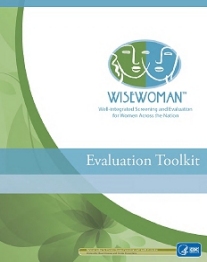WISEWOMAN Program Evaluation Toolkit
Introduction
This evaluation toolkit was developed by the Centers for Disease Control and Prevention’s Division for Heart Disease and Stroke Prevention (DHDSP) and ICF International. The toolkit and accompanying templates are intended to offer guidance and facilitate capacity building on a wide range of evaluation topics. While the toolkit has been designed for a primary audience of staff from WISEWOMAN programs, the concepts and templates included in this toolkit are applicable to a wide audience of individuals involved in program planning and evaluation. We encourage users to adapt the tools and resources in this toolkit to meet their programs’ evaluation needs.
The toolkit is organized into four sections that logically group the steps of the CDC framework. Each section includes a table of contents for easy review and reference.
You can view, download, and print a PDF of each section separately, or as a whole.
Section 1 aligns with Steps 1–3 of the CDC Framework for Program Evaluation in Public Health.
| EVALUATION STEPS |
KEY CONCEPTS |
TOOLS AND TEMPLATES |
STEP 1:
Engage Stakeholders |
- Evaluation stakeholders are individuals and organizations with a stake or vested interest in the evaluation findings.
- Engaging stakeholders can help ensure evaluation use.
- A stakeholder engagement plan can help you ensure that the stakeholders are appropriately engaged throughout the evaluation.
|
- Evaluation stakeholder engagement plan template.
|
STEP 2:
Describe the Program |
- A comprehensive program description is composed of a program logic model and a project narrative.
- A logic model specifically tailored to your program and agreed upon by program and evaluation stakeholders will aid in focusing the evaluation.
|
- Example WISEWOMAN-specific program logic model template.
|
STEP 3:
Focus the Evaluation Design |
- Evaluation questions and needs for information will differ based on the stage of program development.
- Process evaluation enables you to describe and assess your program’s activities and to link your progress to outcomes.
- Outcome evaluation allows you to document health and behavioral outcomes.
- The specific methods used should be driven by your evaluation questions and take into account the availability of existing data and the budget for evaluation.
- An evaluation methods matrix can help organize the planning and implementation processes.
|
- Prioritizing Evaluation Questions template.
- Evaluation methods matrix template.
- Indicator mapping template.
|
Section 2 aligns with Step 4 of the CDC Framework for Program Evaluation in Public Health.
| EVALUATION STEPS |
KEY CONCEPTS |
TOOLS AND TEMPLATES |
STEP 4:
Gather Credible Evidence |
- A data collection protocol can help ensure consistency and fidelity in data collection activities.
- A data collection protocol should specify who is responsible for collecting the data, timing of data collection, procedures for collecting and managing the data, procedures for submitting data, and data security measures.
- Any new data collection efforts should be based on your program’s needs, resources, and also take into consideration the burden on participants and program staff.
|
- Data collection plan template.
- Quantitative data codebook template.
- Qualitative data codebook template.
- Evaluation budget worksheet.
|
Section 3 aligns with Steps 5–6 of the CDC Framework for Program Evaluation in Public Health.
| EVALUATION STEPS |
KEY CONCEPTS |
TOOLS AND TEMPLATES |
STEP 5:
Justify Conclusions |
- Stakeholder engagement is key at this step.
- Analytical approaches should be driven by the specific evaluation questions, the type of data collected, and the audience for the evaluation findings.
- Results should be interpreted with the goals of your program in mind, the social/political context of the program, and the needs of the stakeholders.
|
- Quantitative data analysis plan template—basic approach.
- Quantitative data analysis plan template—advance approach.
- Qualitative data analysis plan template.
|
STEP 6:
Ensure Use and Share Lessons Learned |
- It is not enough to develop a report; consider multiple communication channels for disseminating findings to promote use.
|
- Dissemination plan template.
|
The conclusion presented at the end of Step 6 provides a brief review of key points.
| EVALUATION STEPS |
KEY CONCEPTS |
TOOLS AND TEMPLATES |
| Conclusion |
- Review of the ways to use evaluation.
- Review of key evaluation activities.
- CDC Evaluation Framework.
- Use of evaluation findings to inform ongoing evaluation work as well as program implementation efforts.
|
|
Section 4 is a resource guide that includes selected evaluation resources that may be helpful to you during the planning, implementation, and reporting stages of evaluation. The resource guide also provides a glossary of key terms and a list of references cited.

